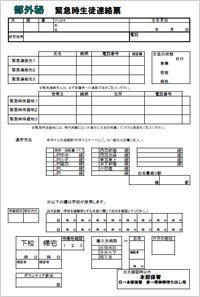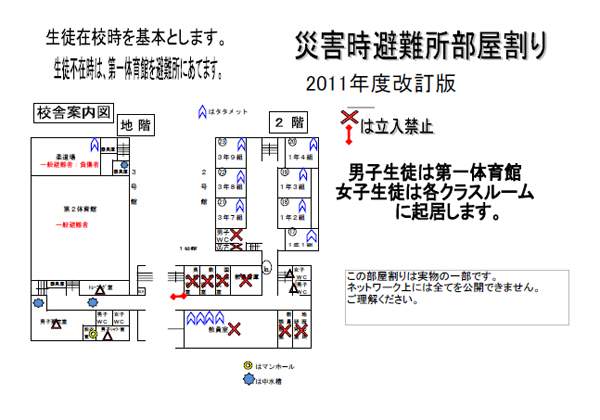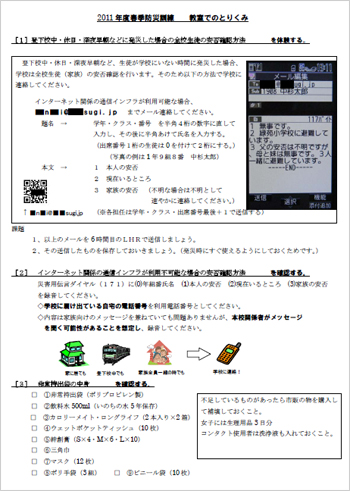Top>Education>Chuo University Suginami High School at the time of the Great East Japan Earthquake.
 Index
Index
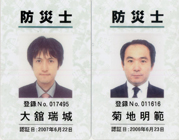
Mizuki Odat・Akinori Kikuchi [Profile]
Chuo University Suginami High School at the time of the Great East Japan Earthquake.
Akinori Kikuchi・Mizuki Odate
Instructor, Chuo University Suginami High School
[Introduction]
We would like to offer our prayers for everyone who died in the recent earthquake, as well as our heartfelt sympathies and condolences for the many victims.
In this article, we will give a moment-by-moment description of actions taken at Chuo University Suginami High School when the Great East Japan Earthquake occurred. In order to heighten disaster preparedness throughout all of society, we believe that it is important to collect and accumulate even the most minute pieces of information. It is our hope that the information provided here will be of use as an example of actions taken at educational facilities.
[When the earthquake struck]
The Great East Japan Earthquake occurred on March 11th when 182 students were present at the school for club activities. The quake continued for a long time. Screams could be heard from the faculty office and materials fell from desks onto the floor. Immediately after the earthquake began, a school announcement was made urging everyone to ensure their safety and to confirm the situation around them. Once the quake had subsided somewhat, the safety of students and staff was confirmed. Any injured persons were asked to report, and we began an evacuation to the athletic field. An aftershock struck once students had lined up on the field. The power lines swayed, tiles fell from the roof of neighboring houses and some students began to cry. According to an announcement by the Japan Meteorological Agency, a shaker in the upper 5 level on the Japanese earthquake scale was recorded in the area around our school. A statue of Buddha and a stone wall next to the school had crumbled.
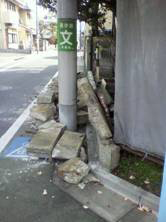
As the aftershocks continued, anxiety and nervousness were apparent in the faces of faculty and staff. What is happening? How should we react? Will our daily disaster preparedness training be of use in this situation?
However, the anxiety felt by faculty and staff did not stem from a lack of understanding regarding how to conduct proper response. Actually, a faculty/staff training session covering our school's response to a large-scale urban disaster had been held two weeks prior to the earthquake. The training session had been held to mark the fifth anniversary since our school had started to revise our disaster preparedness program. Two certified disaster preparation specialists played a central role in creating our school's disaster manual, which was supervised by Mr. Shigeru Hashimoto, Director at the Japanese Bousai Association and the Japan Bousaisi Society (disaster prevention groups). The actual session featured authentic training through instruction by Ms. Kana Miyashita, Executive Director of the Association for Disaster Mitigation and Reconstruction. Although we never expected that an earthquake would occur two weeks after the training, the session provided instructors with the ability to direct students without hesitation. Everyone acted while being conscious of their own role and responsibility.
[On the field after the earthquake]
Students gathered on the athletic field and lined up by club. Instructors checked for injuries and confirmed that all students were present. Students were told to wait on the athletic field for the time being, and were directed to notify their families of their safety by sending an email via mobile phone. Furthermore, we told them to turn off their phones immediately after sending the email in order to conserve battery power. Since daily instruction had been given on how to respond in the case of an earthquake, students faithfully followed orders. Fortunately, no one had been injured at our school.
During this time, instructors gathered information by radio and relayed this information to the students. Several of us went to observe conditions outside the school and assess nearby damage. Blankets and heat-retaining sheets were distributed to students.
After confirming that aftershocks had ended, faculty and staff entered the school in order to assess damage. They confirmed the safety of Gymnasium No. 1, which is a designated emergency shelter. Light rain started to fall, and we led all students to Gymnasium No. 1 at 4:00 PM.
Faculty and staff responding diligently in the school at this time included the school principal, 16 teaching staff consisting of instructors and other teachers, 10 administrative staff, and 7 other staff members such as part-time teachers and club coaches.
[Sending students home/preparation for overnight stay]
After assessing a variety of information, we determined at 5:00 PM that it was possible for students to return home by foot, bicycle or bus. However, trains could not be used at that time. From 5:15 PM, we sent home students for whom transportation was possible. Conversely, we told students who commute by train that they would be staying at the school overnight. During prior training for large-scale disaster, students had been told that they would stay at school until safety could be confirmed. As a result, students took the news very calmly. An emergency student contact list was used to confirm the routes traveled by students on their way home and to issues caution points for when returning. Centralized administration of the student contact list (see Reference 1) was performed at a reception desk established in front of the gymnasium.
Under the supervision of instructors, bags belonging to students were collected and gathered at the gymnasium.
[Greeting night in the gymnasium]
At 5:30 PM, emergency dried bread and water was distributed. Students were instructed to save the food and water contained in their own emergency packs.
At 6:20 PM, faculty and staff who live in the vicinity of the school and have young children were directed to return home.
At 6:40 PM, the approximately 130 students spending the night at school divided into teams to line the floor of the gymnasium with gymnastic mats, exercise mats and cardboard from within the school. Female students used the mats and male students used the cardboard covered with a black curtain. Students wrapped themselves in emergency heat-retaining sheets and passed the time.
A large humidifier was used in the gymnasium. We were fortunate not to have lost electric power, and the gymnasium heater was also used. We decided to permit the charging of mobile phones, and students took turns using the outlets on the wall of the gymnasium.
[Measures for local citizens and people unable to return home]
Schools must fulfill the role of emergency shelter. For that purpose, the allocation of rooms for use as emergency shelters has been determined (see Reference 2). We posted signs to provide guidance for people from outside the school seeking emergency shelter. Although no local citizens or people unable to return home actually came to the school, we were able to perform according to plan.
[Students returning home & students coming back to school]
Students were allowed to return home if their parents came to pick them up. Some students left school after contacting their parents by email and asking to be picked up. On the other hand, there were many cases in which parents were forced to abandon attempts to pick up their children. The condition of roads was worse than we had imagined. Even more surprising was how some students who had started to return home before the disaster came back to school during the night. These students walked back to school after having been stranded at train stations on their way home. They decided that it was closer to walk to school then to their homes. Information gained from these students was extremely valuable.
[The gymnasium late at night]
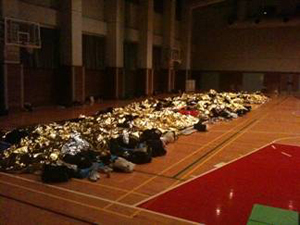
Due to the occurrence of aftershocks, we did not permit students to move freely and ordered them to stay inside the gymnasium. At 10:00 PM we permitted use of vending machines after stationing instructors along the route from the gymnasium. Students purchased a lot of warm and sweet drinks.
Before sleeping, students wearing contact lenses were provided with solution and paper cups.
Lights were turned off at 10:30 PM. We dimmed the lights in the gymnasium and continued to play the radio at a low volume. We also set up four electric hot-water pots so that students could have warm water to drink freely.
The sound of sheets rustling each time that sleepless students rolled over on the floor was particularly impressionable.
[Instructor shifts]
Instructors divided into two groups and took turns sleeping in 3.5 hour shifts from 11:00 PM to 6:00 AM. Some instructors volunteered to stay up all night, but everyone was required to sleep for 3.5 hours.
[Morning in the gymnasium]
Everyone awoke at 6:00 AM and the gymnasium lights were turned on. Instant coffee was distributed to everyone. Breakfast also consisted of dried bread and water.
Using the school homepage, blogs for each grade and the emergency telephone line 171, we instructed all students to notify the school regarding their safety. We also had students staying at school send emails to their friends asking them to contact the school. We asked students to respond with the following information: 1) an email address that can be used to confirm safety, 2) any injuries that may have occurred and 3) their current location. In the case of students who were not at home, we requested that they contact us once again upon returning home. We also announced that school was closed from the 12th to the 14th, and we asked that students avoid going outside and do not send questions to the school via email. All of these cautions points into a QR code which was printed and distributed, and we took a variety of measures to prevent discrepancy in information. Instructors were surprised by the extent of the email network among students. The first confirmation email was received at 6:13 AM and the safety of all students had been confirmed by 6:00 PM that evening. The success of this experience was incorporated into this year's disaster preparedness training, and we established a new method for confirming safety (see Reference 3).
[Students begin to leave school]
Students began returning home at 8:30 AM, once railroads had resumed operation. Instructors announced train lines which had been reopened, and students were able to return home after their route had been confirmed. We had students promise to contact the school by email upon returning home. Students then began to leave school in order. All students had left school by 11:30 AM. Our long, long day was finally over once we had confirmed the safety of all students at 6:00 PM.
[Revising our disaster preparedness plan]
Finally, we would like to summarize all of the actions taken by our school until now. Beginning from 1999, all new students have been required to take courses in basic lifesaving and to acquire certification in lifesaving techniques. Of course, certification has also been acquired by instructors. In other words, everyone in our school has the ability to perform cardiopulmonary resuscitation and to use an AED. Furthermore, certification as a disaster prevention specialist was acquired by Mr. Kikuchi in 2006 and by Mr. Odate in 2007. The two instructors have played a central role in starting new disaster preparedness activities.
[Where to start?]
Our highest priority when starting disaster preparedness activities was to create a school where no one will die. Based on this concept, we worked methodically to develop a safe environment. Specifically, we confirmed the earthquake resistance of school buildings and secured students lockers to the walls. We created the emergency student contact list. (The importance of this list was reconfirmed after the recent earthquake. It was useful to have emergency contact information for all students available even when all homeroom teachers were not present.) Another measure was to revise evacuation routes and to modify evacuation training. (We assigned names to all stairways and affixed the corresponding name to each stairway. Evacuation routes were posted both in hallways and in classrooms, clearly indicating the evacuation route to be taken from the present location. In the past, even such obvious measures had not been thoroughly implemented. Moreover, evacuation training was changed to disaster preparedness training. In 2009, we installed an emergency earthquake broadcast system and prepared a response to such emergency broadcasts. We also held role-playing in classrooms in order to practice methods for confirming safety. In some cases, students also studied disaster preparedness (see Reference 4![]() ). We committed ourselves to conducting authentic evacuation activities. When giving orders, instructors started to wear the folding helmet which was hung from each teacher's desk.) We also ensured a safe environment by creating a list to allocate rooms used for emergency shelter in the time of disaster, as well as by clarifying restricted areas. We prepared "No Entry" labels and stored them together with cellophane tape so that anyone could quickly seal off restricted areas. Through such measures, we created a system for guiding local citizens who evacuated to our school. Finally, we prepared emergency bags for students from 2010, and students began to store basic medicine, foods and water in their personal lockers.
). We committed ourselves to conducting authentic evacuation activities. When giving orders, instructors started to wear the folding helmet which was hung from each teacher's desk.) We also ensured a safe environment by creating a list to allocate rooms used for emergency shelter in the time of disaster, as well as by clarifying restricted areas. We prepared "No Entry" labels and stored them together with cellophane tape so that anyone could quickly seal off restricted areas. Through such measures, we created a system for guiding local citizens who evacuated to our school. Finally, we prepared emergency bags for students from 2010, and students began to store basic medicine, foods and water in their personal lockers.
We have also taken other methodical steps for realizing disaster preparedness, including creation a manual for using toilets during times of disaster (see Reference 5![]() ), creating evacuee cards, and installing spotlights.
), creating evacuee cards, and installing spotlights.
In the future, Suginami High School will continue to lead private schools by conducting disaster preparedness education.
- Akinori Kikuchi
Instructor, Chuo University Suginami High School - Born in 1963 in Saitama Prefecture. Graduated from the Department of Literature at the Chuo University Faculty of Letters in 1986. Majored in Japanese literature. In 1988, completed the Master's Program in Japanese literature at the Chuo University Graduate School of Letters. In 1993, left the Doctoral Program in Japanese literature at the Chuo University Graduate School of Letters.
Assumed current position in 1993 after serving as an instructor at Hyosung Women's University in Korea.
Major written works include Eiyoshu: Volumes 1 and 2 (co-authored, Koten Bunko Publishing, 2002) and Japanese: Curriculum in New Standard Japanese-Intermediate 1/2 (co-authored, Dairen Shuppan Publishing, 2010) - Mizuki Odate
Instructor, Chuo University Suginami High School - Born in 1975 in Saitama Prefecture. Graduated from the Department of Literature at the Chuo University Faculty of Letters in 1998. Majored in Japanese literature. In 2001, completed the Master's Program in education at the Chuo University Graduate School of Letters. Has served as an instructor at Chuo University Suginami High School, his alma mater, since 2002. Acquired certification in disaster prevention in 2007 and works to improve the disaster preparedness of the high school.
- http://youtu.be/cgkBJxtUnIA

- Research Activities as a Member of Research Fellowship for Young Scientists (DC1), Japan Society for the Promotion of Science (JSPS) Shuma Tsurumi
- Important Factors for Innovation in Payment Services Nobuhiko Sugiura
- Beyond the Concepts of Fellow Citizens and Foreigners— To Achieve SDGs Goal 10 “Reduce Inequality Within and Among Countries” Rika Lee
- Diary of Struggles in Cambodia Fumie Fukuoka
- How Can We Measure Learning Ability?
—Analysis of a Competency Self-Assessment Questionnaire— Yu Saito / Yoko Neha - The Making of the Movie Kirakira Megane








